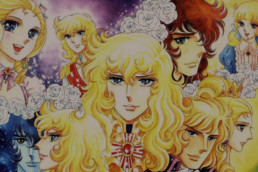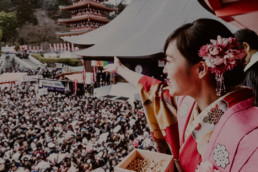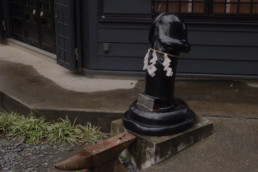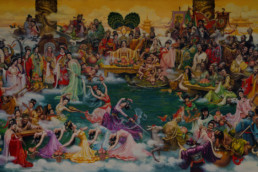Japan Folklore: Oni
Oni, yōkai in Japanese folklore
From a benevolent creature to an evil one. This is the slow transformation of the Oni (鬼), the Japanese mythological creatures that we Westerners call "demons", "trolls" or "orcs".
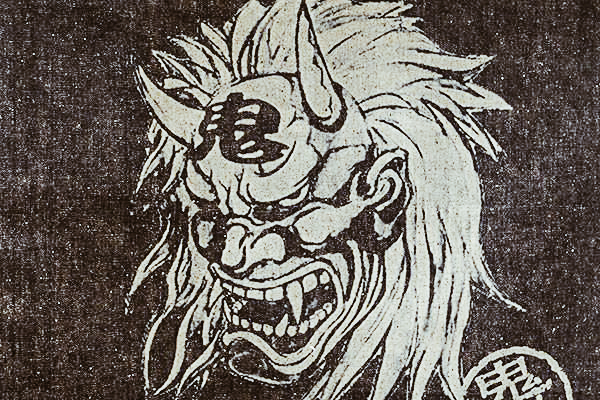
photo credits: tateandyoko.com
Before the Heian era, the Oni were good spirits able to ward off evil. However, during this era, they were relegated to the role of guardians of hell or torturers of damned souls. An example of this is the aka-oni (red demon) and the ao-oni (blue demon) described in the Buddhist tradition, which take on a negative connotation and become spirits to be kept away. In fact, they are considered as carriers of misfortune or agents of natural disasters.
Their appearance is certainly not reassuring. In fact, they are said to have animalistic and monstrous features, sometimes with many eyes and colored skin (red, blue, black, pink or green). They can also be clawed, wear tiger skin and carry kanabō (金棒, literally: "metal stick", a spiked war bat used in feudal Japan by the Samurai).
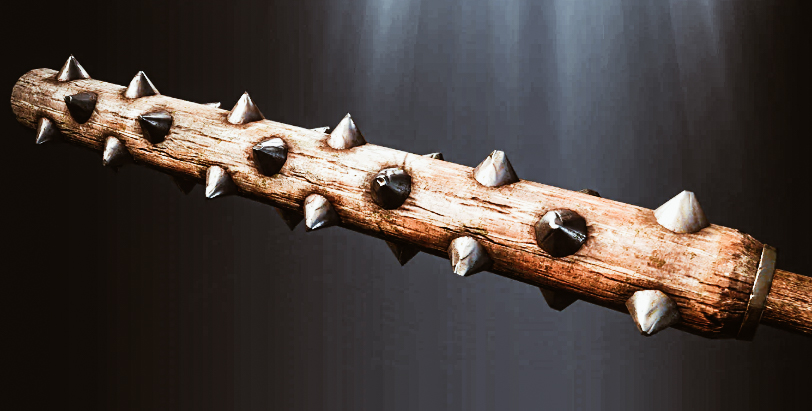
photo credits: forhonor.ubisoft.com
Demon Get out! Luck get inside!
In the Nara era, to avert the disasters that these spirits could provoke, people used to practice oniyarai (追儺), a ritual aimed at driving out the demon.
On the last day of each year, a person used to dress in the demon's clothes and was chased away with peach bows and reeds. Over time this custom turned into the Setsubun celebrations, in which people throw soybeans out of the house saying: "Oni wa soto! Fuku wa uchi! "(Oni out! Luck inside!).
Despite being considered evil spirits, in tradition, there are still traces of their benevolent nature. We find these during the parades when some men wear the Oni costume to ward off bad luck. They are also depicted on the tiles of some buildings for the same reason.
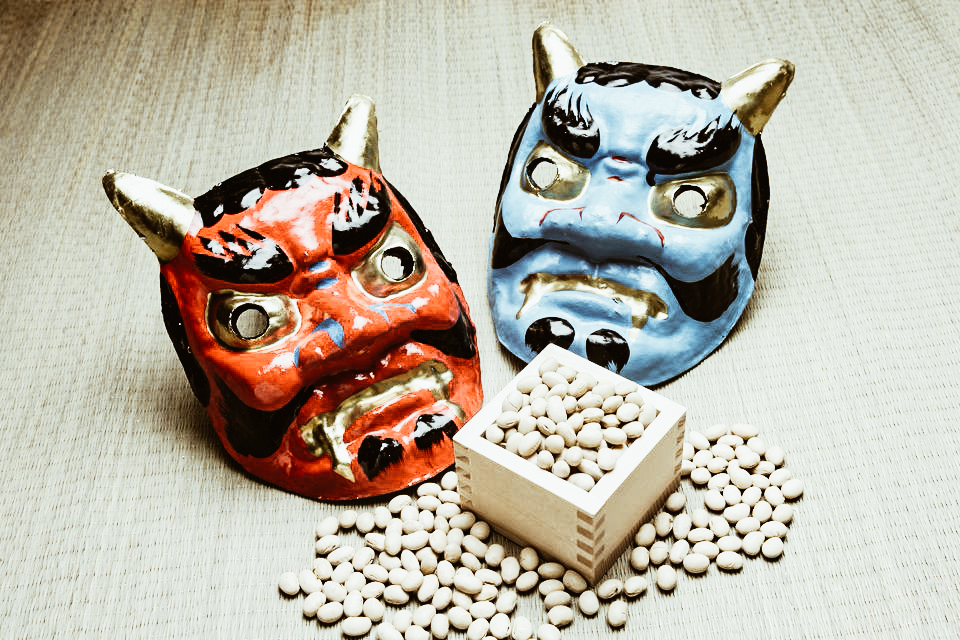
photo credits: tripsavvy.com
The many curiosities of modern culture
Today we meet these demons not only in folkloristic stories and nursery rhymes for children but also as protagonists of proverbs! In fact, it is said that "Even in the eyes of the oni tears arise" (鬼の目にも涙) to indicate that even the hardest heart sometimes feels pity. Another proverb is "The wife of an oni becomes an oni divinity" (鬼の女房鬼神がなる) which refers to our "disciple surpasses the master".
Of course, it was unthinkable not to use such a particular figure in animes and mangas! There are endless references to these spirits, and one of the most famous and well-known is Lamù, the main character of Rumiko Takahashi's manga. But it is not the only one. In fact, even in The Blue Seal by Chie Shinohara the Queen of the Oni is the protagonist. There is also Shutendoji by Gō Nagai whose work title refers to the legend of an oni of the same name.
Among the most played and entertaining horror/adventure video games we cannot forget Ao Oni. Here the main antagonist is a blue demon whose anime adaptation was broadcast in Japan between October 2nd, 2016 and January 8th, 2017. The 13 3-minute long episodes were also streamed in Italy under the title Aooni The Blue Monster (あおに〜じ・あにめぇしょん〜). Despite its simplicity, Ao Oni is terrifying thanks to the background music that gives the videogame the right scary atmosphere!

photo credits: giantbomb.com
Japan Folklore: Nippombashi Street Festa
photo credits: jnto.go.jp
In Osaka, anime and manga come to life
Every year since 2005, between early days and mid-March, the streets of Den Den Town located between Ebisucho Station and Nihonbashi are closed to car traffic for the biggest cosplay event in all of Japan: the Nippombashi Street Festa (日本橋ストリートフェスタ).
Den Den Town is the electronic district of Osaka that, thanks to its toy stores, video games stores and computer stores, has begun to attract a large number of manga and anime fans, soon turning into one of the "sacred" destinations for Otaku. Each year the festival is enhanced by attracting not only the local but also a more international audience!

photo credits: reddit.com
The Festival begins!
Preparations for the event start around 11:00 am with the roads closing to traffic. Here, above the street the main stage on which guests, cosplayers and sponsors alternate throughout the day is built.
The opening ceremony begins at 12.00 pm when a road is created for the parade of the 1,000 best cosplayers from around the world. After the show, cosplayers perform and pose for all those wishing to approach their favorite character. Many of them take advantage of the event to promote their socials accounts, writing their address on whiteboards or signs placed next to them while they are immortalized in the poses studied in advance.
Obviously the event is not open only to professionals, but hundreds and hundreds of people wear their own costume. It doesn’t matter if this belongs to pop culture, anime, manga, video games or even cartoons and characters from American comics (especially Marvel, Adventure Time and Star Wars), almost 10,000 people a year turn into their own hero! Of course, the festival is free, but if you want to participate in the parade, an entry fee of around 1,500 yen is needed.
The event is also the perfect opportunity to find unique designs by Nippombashi Street Festa and exclusive goods.

photo credits: nippombashi.jp
The cultural exchange project between Japan and France and an exceptional ambassador
From 2018, year of the 160th anniversary of friendship between France and Japan, the 「Japan-France pop culture Exchange project」was promoted in order to deepen the cultural exchange between manga, animation, music and other aspects of Japanese pop culture with the France in collaboration with the「Japan Expo」.
To disseminate the event and make it even more alive, KAMIJO, the talented Japanese artist who became particularly famous in France, was chosen as the project's ambassador.
This year the Nippombashi Street Festival will be held on March 9th and will be the perfect opportunity to immerse yourself not only in the magical world of fantasy, but also in the musical world!
Japan Folklore: Versailles no bara, the best-selling manga

photo credit: nefariousreviews.com
In 1972, Riyoko Ikeda created what became the manga and, later, the most famous anime of all time: "Versailles no Bara" (ベルサイユのばら, The Roses of Versailles, known in Italy as Lady Oscar). The talented mangaka, whose meticulous and elegant style has come to stand out and be considered the Shōjo Teacher, had to face her own publisher before seeing her published idea. The publisher was in fact convinced that a biographical manga starring Marie Antoinette could bore readers. Riyoko Ikeda undertook to prove otherwise and in May 1972 the first instalment of "Versailles no Bara" appeared on Shukan Margaret issue number 21, published by Shūeisha, on a weekly basis for a total of 82 episodes ended in 1973.
Between 1972 and 1974, 15 million copies were sold, thus electing Riyoko Ikeda as the queen of the historical manga.
photo credit: supereva.it
The history of the roses of Versailles and the wind that swept over them
In the last years of the Ancien Régime, the young Marie Antoinette of Austria was promised to marry the French dolphin, Luigi Augusto, nephew of Louis XV but his cousin, the Duke of Orleans plotted to kill him and usurp the throne. At the head of the Royal Guard was Oscar François de Jarjayes, a young noblewoman raised by her father, General De Jarjayes, as if she were a boy because he wanted a male heir. Alongside Oscar was a young attendant, André Grandier, nephew of the housekeeper of the Jarjayes family, to whom the General had entrusted the task of serving and protecting her. Covering her role, Oscar foiled many plots that aimed to kill the two princes, thus leading to being esteemed and considered a friend by Marie Antoinette. The capricious future queen, escorted by Oscar at a ball court, met the Swedish count Hans Axel von Fersen, of whom both women fall in love.
At the death of the King, Marie Antoinette and Louis XVI became sovereigns of France and, since the slander on a presumed relationship between Fersen and the Queen did not take long to spread, the count abandoned the country to avoid scandal and enlisted in support of the revolutionaries of America. Marie Antoinette, more and more unhappy and lonely, allowed herself to be influenced by the Countess of Polignac, an ambitious woman who became her favourite and urged the queen to squander money in frivolity. After a few years, the Count of Fersen returned to France and inevitably went back to Marie Antoinette, who, unable to control her feelings, was on the verge of a scandal. Once again the count left the country and the queen, following the birth of the heirs to the throne, decided to move away from the life of the court and retire with her children in the Petit Trianon, arousing the hatred of the high nobility. In the meantime, the famous "Deal of the Necklace" broke out, which threw the first shadows on the public reputation of the queen. Shortly after, Fersen returned from America and during a court ball, Oscar showed up in disguise dressed for the first and only time as a woman but, dancing with Fersen, realized that she could never replace the queen in the heart of the Swedish count and she decided it was probably better to live forever like a man. Following the case of the Black Knight and the further attempt to discredit the royal family in the eyes of the nobility, Oscar abandoned the command of the Royal Guard obtaining from the queen the post of commander of the French Guards regiment of Paris. André, despite being rejected by Oscar after declaring her love, he remained by her side anyway.
General Jarjayes realized that he had made a mistake in allocating his daughter to a military career and began to wish that she would marry, so the second of Oscar in the Royal Guard, Girondel, made her a marriage proposal, but Oscar did not accept, preferring her new soldiers and attempts to earn their respect. The French revolution was at the door: Oscar, who understood to love Andrè, sided with him on the side of the people and together died during the riots of the storming of the Bastille July 14, 1789. The years of the revolution lasted until Marie Antoinette’s execution on the guillotine on October 16, 1793.
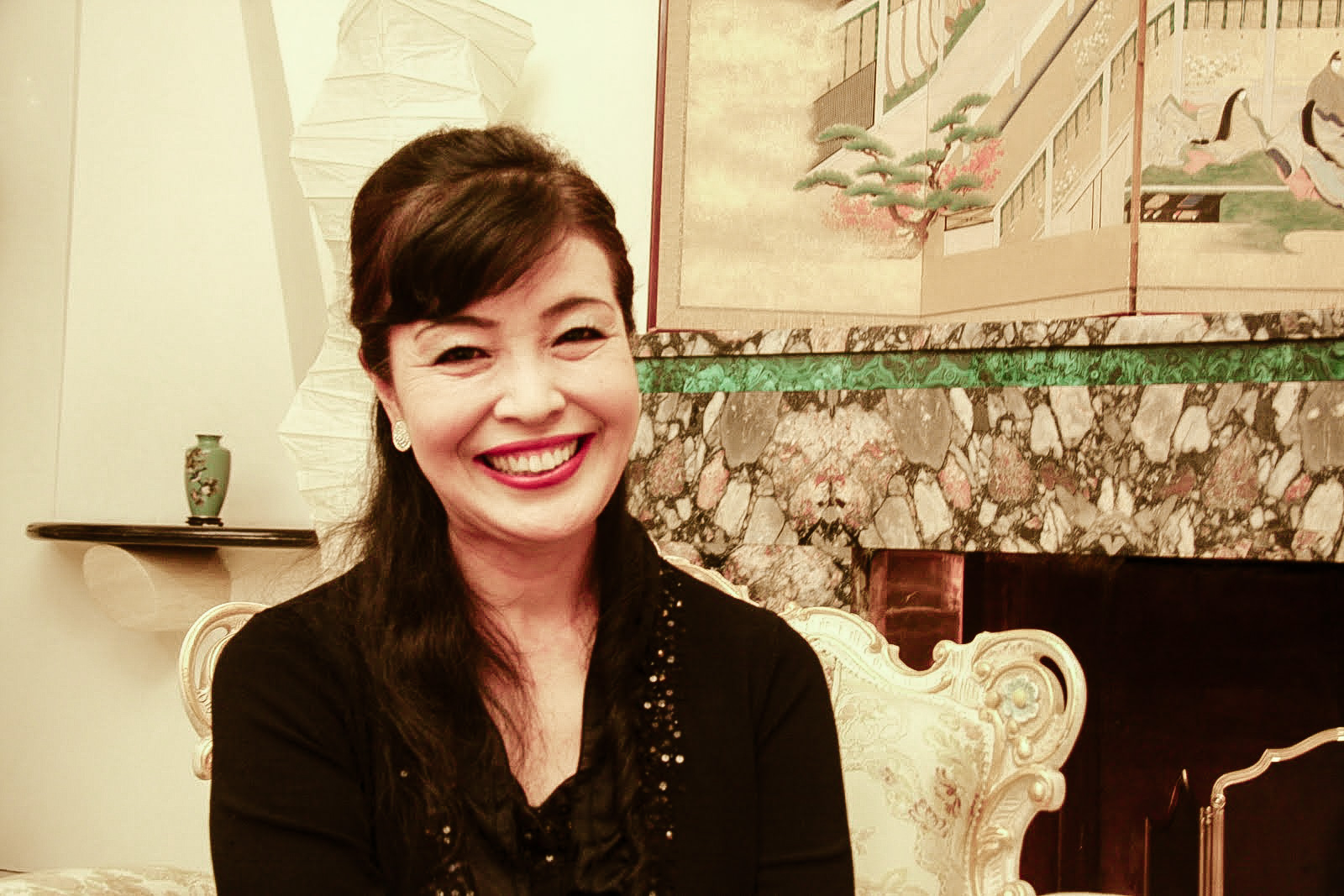
photo credit: romaspettacolo.net
One series is not enough!
Twelve years after the mother series, Riyoko Ikeda decided to publish a 4-episode miniseries entitled Versailles no bara gaiden (The Roses of Versailles - Gothic Stories) whose protagonists are Oscar, Andrè and the little Loulou de La Lorencie, Oscar's niece. The episodes narrated are placed between volumes 7 and 8 of the original manga. In 1987 Eikō no Napoleon-Eroika (栄光のナポレオン-エロイカ, The glorious Napoleon - Heroic) also appeared as the official sequel, whose title "Eroika" refers to the third symphony of Ludwig van Beethoven, dedicated to Napoleon. These 12 volumes narrate the events of Napoleon immediately after the French Revolution: his empire, the Italian campaign, the campaign of Egypt, the battle of the Nile, the coup d'etat of the 18th Brumaire and the French invasion of Russia. in the course of the narration, some of the already known characters will reappear, but only through flashbacks.
In 2006, Riyoko Ikeda decided to take the pencil again to create "Berubara Kids": an amusing reinterpretation in coloured stripes in which the characters of Versailles no Bara reappear in "chibi" version in key scenes. The small parody was published weekly on "Be", a supplement of the newspaper "Asahi Shimbun".

photo credit: pinterest.it
Roses die in beauty
The fascination of Versailles no Bara pushed many musicians to reinterpret the famous "Bara wa utsukushiku chiru" original song of the anime, but Riyoko Ikeda recognized the LAREINE version with license. The first CD came out on October 1, 1998 and in limited number of copies: only 500 with serial number of which the first 4 were owned by the members of the group. Fortunately, in 1998 it was re-edited and Bara wa utsukushiku chiru officially became the fourth single of the band. On February 9th 2000 the most valuable CD edition was released, containing only two audio tracks in which Riyoko Ikeda herself participated as a soprano singer and took care of the graphic design, also designing the costumes of the band for the music video.
Japan Folklore: Setsubun, how to drive away the demons of winter to welcome spring

photo credits: pinterest.it
Traditional Japanese culture has always been characterized by a constant and loving observation of the natural world, its manifestations and its seasonal cycles. Therefore, the attention given to spring, the special moment when nature awakens in all its creatures the necessity of renewal, must not marvel.
This season is celebrated in Japan with the haru matsuri (春祭, spring festival), a set of events whose beginning is marked by the occurrence of Setsubun (節 分). In the traditional Japanese lunisolar calendar, in fact, every change of season is introduced by a day called, indeed, setsubun (literally "division of the seasons"). Spring setsubun, which falls on 3 February, represents the last day of winter and the day before the start of the new season. It marks the transition from "Taikan" (大寒, big cold) to "Risshun" (立春, first day of spring) and is therefore the most favorable moment for a special "cleaning" from winter burdens, which will drive away evil spirits and favor the entrance of the new life-giving energy. This is the meaning of the traditional "demon expulsion" that takes place on this day through different rituals and customs.
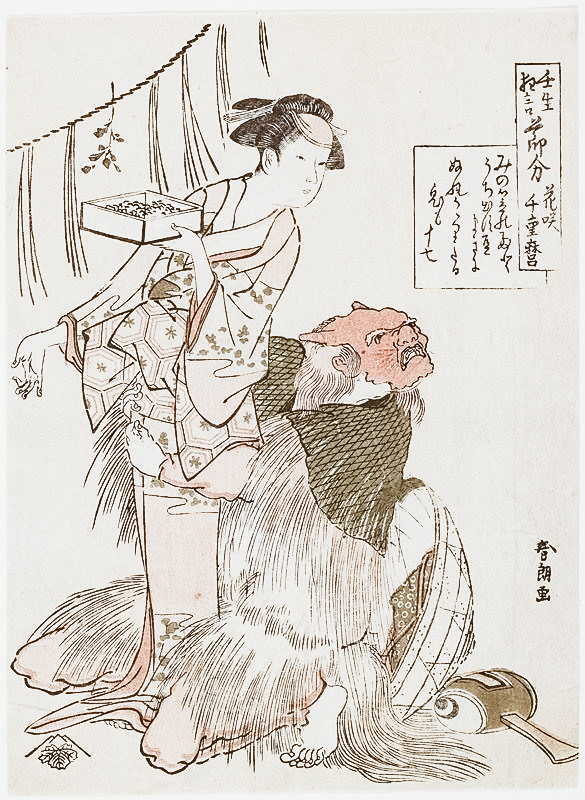
photo credits: pinimg.com
Ancient rituals and family fun
The most famous ritual is undoubtedly the mamemaki (豆 撒 き), which is the launch of soy beans. In the domestic sphere it is entrusted to Toshi Otoko (年 男, man of the year), that is the man of the family of the zodiacal sign of the lunar year entering or in his absence the oldest of the house. He has the task of driving out the harmful spirits and negativities from the house and the new year that is about to start by throwing around irimame (炒 り 豆, toasted soy beans) to the cry of "Oni wa soto! Fuku wa uchi! (鬼は外! 福は内, "Outside the demons! Inside fortune!"). In alternative, he can hurl the beans at another member of the family who plays the part of the demon wearing a mask of oni (Japanese folklore ogres). Subsequently, each member of the family must collect and eat a number of beans corresponding to their age plus one to ensure a year of success and good health (in the popular tradition, in fact, the demons are considered carriers of natural disasters and diseases).
When the oni is expelled, it is necessary to keep the evil spirits away from the house. For this reason it is possible to see in this period of the year some very special amulets, the Hiiragi Iwashi (柊 鰯), exposed at the entrance of the houses. These are holly branches that have the head of a dried sardine skewered on the end, sometimes complemented by pieces of garlic or onion, which have the purpose of keeping demons away, scared by the thorns and the pungent odor emanating from these talismans.
In both cases it is a tradition that has its roots in antiquity. Nowadays it is possible to buy "Setsubun sets" - made of oni masks and roasted beans - in any combini, but in reality the mamemaki custom would have originated in the Muromachi period (1392-1573) and seems to be inspired to an ancient legend, whose plot is still represented in the form of pantomime in the temple of Mibu-dera in Kyoto. Here the kyogen (ancient Japanese theatrical form) titled "Setsubun" is repeated several times during the day and it is said that it is sufficient to watch it to be purified by any negative or evil spirit. Its plot follows the folk tale that tells of an ogre who, in human form, goes one day to visit a widow. Thanks to its magic hammer, the ogre makes a beautiful kimono, which attracts the widow's attention. Eager to take possession not only of the kimono but also of the magic hammer, she decides to get him drunk to be able to steal them both. The ogre, however, aware of the theft, reveals his demonic nature and attacks the woman, who defends herself with the first thing that is within reach: a handful of soy beans. The oni, wounded but again in possession of his goods, flees leaving the widow safe and sound and perhaps a little wiser.

photo credits: toyokeizai.net
Knowing how to look in the right direction
A tradition of more recent origins, born in Osaka but later spread to the rest of the country, is instead linked to the ehōmaki (恵 方 巻, scroll of lucky direction). In this case, to ensure that the good luck is on our side in the year that is about to begin, it is necessary to eat a special sushi roll in a single solution, without interruptions and in silence, facing the lucky direction of the year. The act is less simple than it may seem, considering that the ehōmaki is much more often than a common sushi roll (having to contain seven ingredients to propitiate the seven gods of luck) and is 20 centimeters long. It is not worth eating it cut into pieces, because doing so would also cut luck. To perform the ritual correctly, it is therefore necessary to arm yourself with concentration, determination and a precise compass. For those interested in experimenting with this custom, the most common ingredients to obtain for the filling are cucumber, surimi, salmon, tuna, anago (sea eel), tamagoyaki (Japanese omelette), dried kanpyo strips and seasoned (Japanese pumpkin) and shiitake mushrooms, as well as rice and nori seaweed, while the lucky direction for 2019 is East-North East.
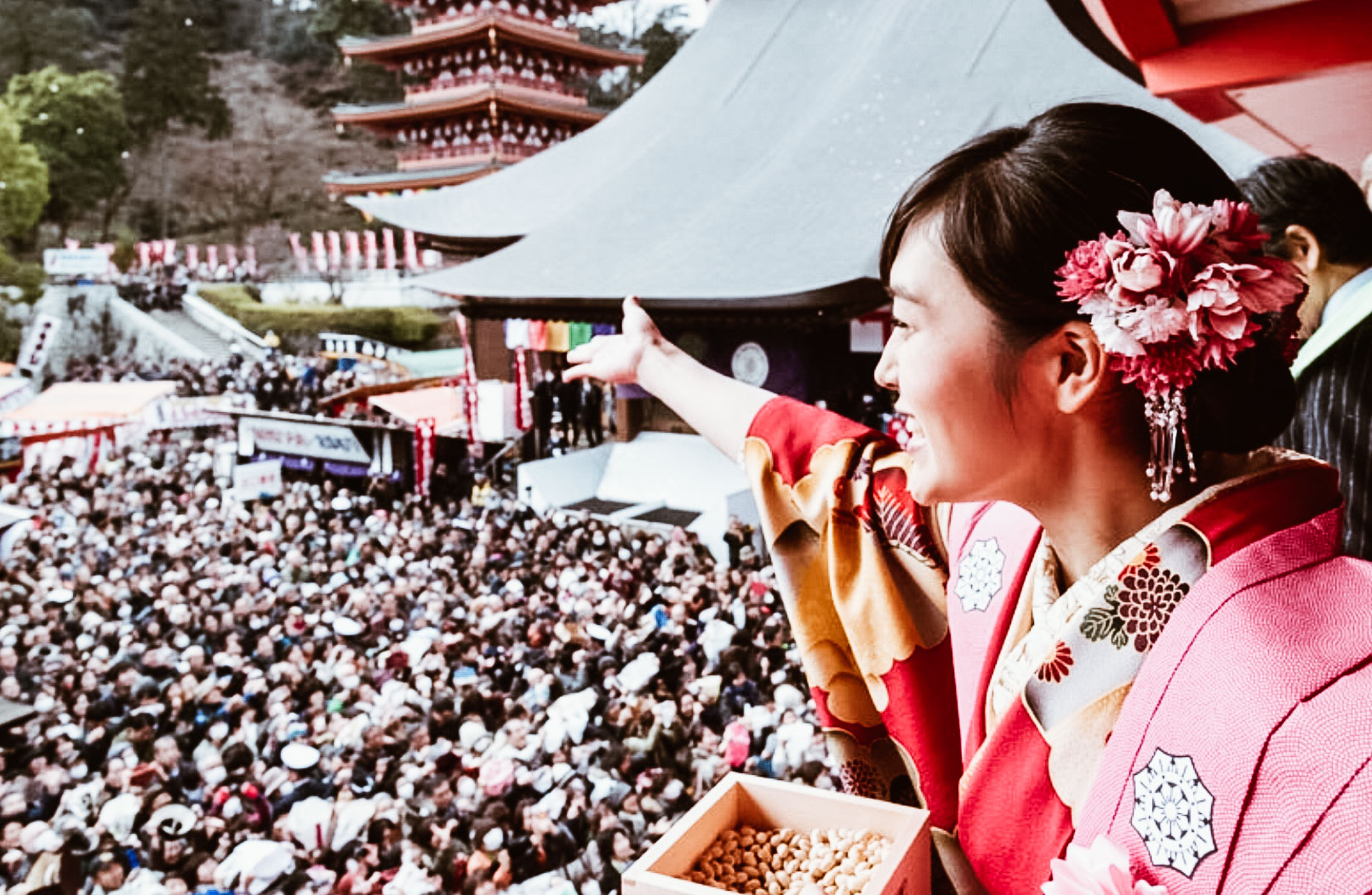
photo credits: shinsenhino.com
Festive temples
The Setsubun can be celebrated in a domestic environment or at least in a private dimension, with relatives and friends, but it is also and above all a recurrence to be lived in community. For example, schools often organize moments of recreation for children, who wear oni masks or have fun chasing adults dressed as demons while hurling beans against them. But it is especially in the temples that it is possible to experience the collective dimension of the party, participating in the events specially created for this day. First of all, of course, the mamemaki, carried out by the monks who throw soy beans from the top of the stages on the crowd gathered for the event. In some temples more shifts are organized for this ritual, reserving some special ones for children, who in addition to the beans receive sweets or small gifts. In addition to the monks, celebrities are often present, such as sports champions, personalities of the entertainment world, actors of the kabuki theater, geisha and maiko, television celebrities, who add a note of attractive glamor to traditional festivities. Among the latter we must remember the theatrical performances, the various purification ceremonies or even the striking archery performances, in which the archers throw their arrows at targets that have demon-like features.
In short, Setsubun is the ideal day for those who wish to live in company a start of the year that helps to renew their energies and for families who have the opportunity to spend a moment of joy together, something that always remains the best talisman against all evil at every latitude.
Japan Folklore: Kanamara Matsuri
Kanamara Matsuri

Photo credits: pictureasiastudio.wordpress.com
The festival of the "Steel Phallus"
The Kanamara Matsuri (かなまら祭り) is often welcomed by foreigners as yet another quirk from Japan, but in fact, the origins of this festival are very old and they are related to Shinto religion.
It all began in the Edo period, in 1603, when the town of Kawasaki was the destination for travelers who found their enjoyment in tea houses and, in private, entertained themselves with prostitutes. Prostitutes that used to visit the Kanayama temple to pray for protection from sexually transmitted diseases.
There is also a legend that revolves around the name of the Kanamara Matsuri, according to which a demon with sharp teeth lived in the vagina of a young girl. Any man who had intimate relations with her ended up irreparably castrated. Her husband too fell victim of the demon on the first wedding night and the girl, now desperate, asked for help to a blacksmith. The man forged an iron phallus that broke the demon's teeth and freed the woman from the curse. To celebrate, a small Shinto temple was erected becoming the place where the iron phallus is still venerated today.
The tradition was lost in late 1800s but, in the 1970s, chief priest Hirohiko Nakamura decided to revive the lost festival.
For centuries, the Kanayama temple has been the place where couples pray for a child, or where to pray for luck in business, an easy delivery or simply family harmony.

Photo credits: matome.naver.jp
3 Mikoshi and no preconcept
Every year, on the first Sunday of April, priests of the Kanayama Jinja in Kawasaki organize this festival.
The parade opens up with a shinto ceremony at the shrine where sake and fried fish are distributed to all visitors as a wish for good luck. Finally, the big pink penis placed on an altar is brought to the temple. At this point, the parade actually starts following three mikoshi, each containing a huge phallus. The first one stands erect and is made of a polished black metal. The second is an old wooden one, ancient and gnarled, and both are transported by carriers of the shrine who sing along the procession. The third one is entrusted to a joso group: they are members of a cross-dressing club called Elizabeth Kaikan. Its members, with their bright make-up and colored wigs, move the mikoshi in the air preening for the cameras.
After the parade, everyone gather to enjoy street-food, sexual-themed competitions and the cheerful atmosphere. Among the proposed challenges there is the sculpture contest, with sculpture that must have a phallic shape of course, or a rodeo with a big rotating penis. The festival is attended both by locals and tourists that, for the occasion, leave aside all taboos. The great majority of people wear all sorts of extravagant things, as fake penis-noses, while eating foods of the same shape.
We can also come across young women posing for photos while riding on swings that for the occasion have the shape of wooden penises.
This Festival, still loyal to its origins, celebrates sexual awareness and the prosperity of the whole community donating all the proceeds to HIV research.

Photo credits: flickr.com
Japan Folklore: Miko
Miko (巫女)
"The Shrine Maiden"
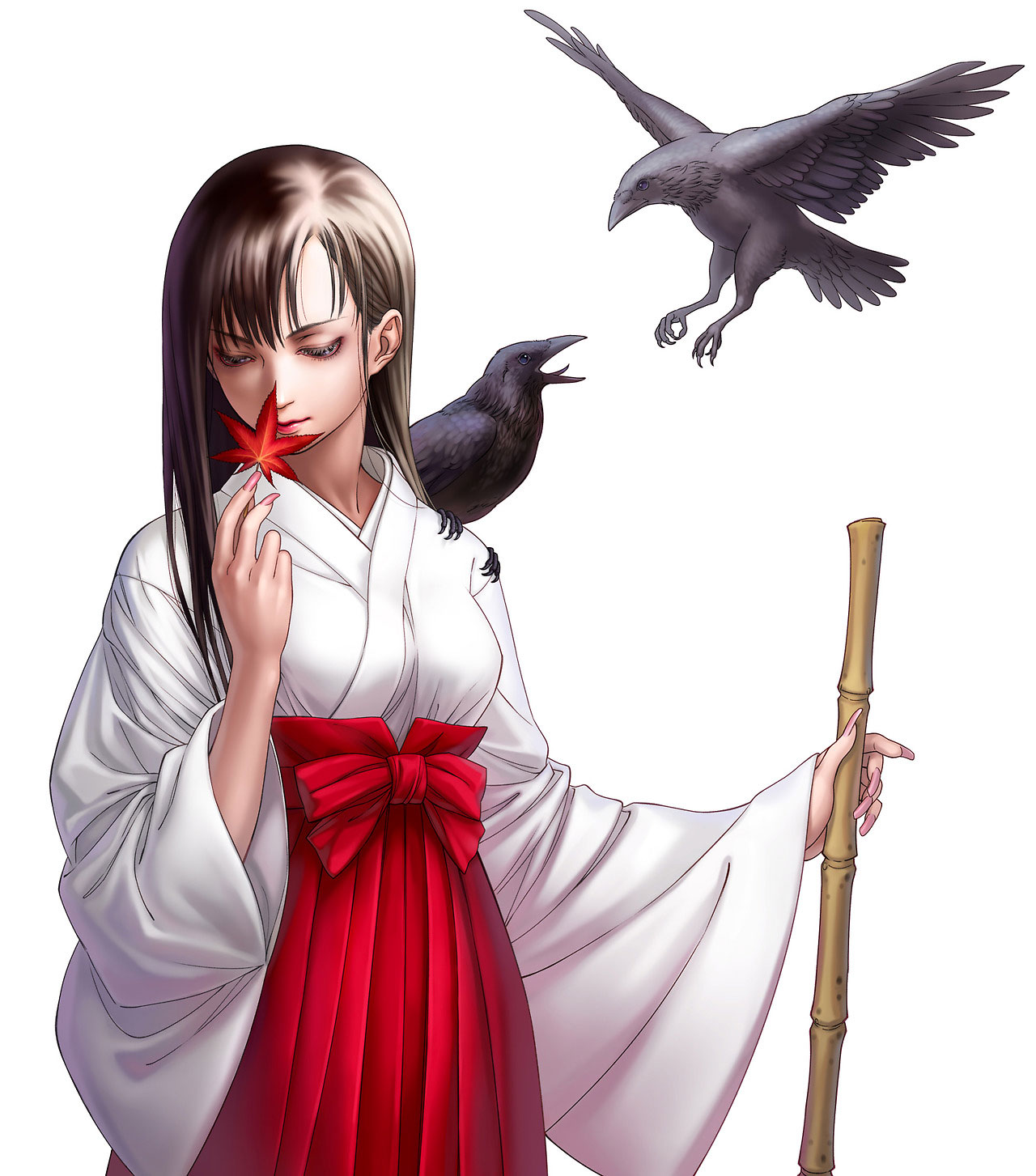
Photo credits: pinterest.com
We have seen them in many different anime: Rei Hino, the brave Sailor Mars from Bishōjo senshi Sērā Mūn, the mysterious Kikyō from Inuyasha, or the cheerful Hiiragi twins from Lucky Star.
All these characters shared the same occupation: they were miko, girls that serve as helpers in Shinto temples managing various functions. In fact, we find miko committed to helping the priest in his functions, they keep the temple clean and collect the offerings of worshippers.
Defining this figure by Western standards in very difficult. Miko are not comparable to Christian nun, nor are they actual Priests, even though in Shinto women are allowed to become priests. They are more similar to the oracles of ancient Greece, or to shamans, as in ancient times they were gifted with the possibility to talk with the kami, Shinto deities. By entering a state of trance, they could intercede with the gods and then communicate their will to the humans. These divinatory gifts and their ability to communicate with the world of the spirits were recognized as Divine will.
The origins

Photo credits: dannychoo.com
Their origin dates back to the Jōmon period, the Japanese Prehistory, which goes from around 10,000 BC. up to 300 AD. One of the earliest record of anything resembling the word ‘miko’ can be found in the name of the Shaman queen Himiko (c. 175 - 248). She was the ruler of the Yamatai, the most powerful among the kingdoms in which archaic Japan was divided. But we do not know if Himiko was a miko or not.
The word ‘miko’ is made of the kanji 巫 "shaman, unmarried virgin", and 女 "woman", and it is generally translated as ‘Shrine maiden’. An archaic form of the word is 神子 “Divine child”.
Their strong connection with the deities is also testified by the fact that miko danced the kagura (神楽), literaly "god-entertainment” or “music for the gods". This is an ancient Shinto dance rooted in Japanese folklore that links to the goddess of dawn, Ama-no-Uzume. It is said that with this dance the goddess managed to convince Amaterasu, the goddess of sun, to leave the cave where she was hiding after quarreling with her brother Susanoo, the god of the storm.
The kagura dance was often presented at the imperial court by those miko who were in fact seen as the descendants of Ama-no-Uzume.
In ancient times, miko were considered essential social figures, and this role meant great commitment and responsibility. Their divine bond identified them as messengers of the will of the kami, but not only this. It also placed them in the position to influence the social and political life, and therefore the fate of the village where they served.
However, they underwent a considerable crisis starting mainly from the Kamakura period (1118-1333). In fact, there were attempts to try to take hold of their shamanic practices, and miko, without anymore funds, were forced into a state of mendicancy. Some of them sadly fell into prostitution.
After a period of great transformations during the Edo period, in 1873, the Religious Affairs Department (教部) issued an edict called Miko Kindanrei (巫女禁断令). It prohibited all spiritual practices of young miko.
How to become a miko

Photo credits: thirteensatlas.wordpress.com
The path to become miko was long and difficult. Chosen by the clan on the basis of her spiritual strength, or because she wa a direct descent of a shaman, the girl began her preparation at a young age, usually with the first menstruation. It took three to seven years to become a full-fledged miko.
The girls would wash in cold water, practice abstinence, and perform other purification acts. Everything was aimed at learning how to control their state of trance.
They learned a secret language only known to shamans, and they also needed to learn the names of all the kami relevant to their village. They also learned the divinatory art of fortune-telling and the dances they needed to perform in order to enter the state of trance necessary to talk with the deity.
At the completion of this training there was a ceremony that symbolized the marriage between the miko and the kami she would serve. Dressed in a white robe that represented her previous life, the girl entered a state of trance and was asked which kami would she serve. After that, a rice cake was thrown at her face causing her to faint and she was laid down in a warm bed until she woke up. Then, she would wear a colorful kimono symbolizing her marriage with the deity .
Due to this bond with the deity, young girls had to remain virgin. Still, there were cases of miko with a particularly strong spiritual power that continued their service even after marriage.
Miko today

Photo credits: muza-chan.net
Nowadays the figure of miko still exists but they are mostly young university girls who work part-time at the temple. They assist the kannushi or 'man of god' in the various functions and rites of the temple, perform ceremonial dances, keep the temple clean and sell omikuji, sheets of paper on which is written a divine prediction. They generally do not need any specific preparation and do not necessarily need to be virgins, though they are still required to be unmarried. The kagura dance has become a mere ceremonial dance and it is no longer a way of coming into contact with the divine entity.
Their traditional outfit consists of a white haori representing their pureness, for the upper part of the body, and a pair of red hakama. Red or white are the ribbons in their hair.
During the ceremonies they use bells, sakaki branches, or offer prayers playing a drum. Among other ritual objects there is also the azusa-yumi, a bow that was once used to ward off evil spirits. In the past they also used mirrors to attract the kami and katana.
Maybe miko have lost their divine bond, but they still retain the millenary tradition of taking care of the temple, remaining one the most famous figures of modern Japan.

Photo credits: pinterest.com
Japan Folklore: Hōnen Matsuri
Hōnen Matsuri

Photo Credits: google.it
The Honen Matsuri is celebrated every year on March 15 throughout Japan. The most famous one takes place at the Tagata Jinja, in the small town of Komaki, outside Nagoya, with photos and videos available on the Internet. But in other parts of Japan, such as the Honen Matsuri of Okinawa, this festival is still considered a sacred and secret rite and no photo or recording is allowed. Even speaking or writing about what has been seen is technically prohibited.
Hōnen Matsuri (豊年祭), literally “Harvest Festival”, has a 1500-year-long history: its purpose is to guarantee the fertility of the harvest for the following year. A ritual full of blessings for the harvest, but also for all sorts of prosperity and fertility in general. This celebration could take on obscene features, at least in western eyes, because its symbol is a 280 kg cypress pine phallus, with a length of 2.5 meters. But it is absolutely not like that.
Phallic rites have in fact prehistoric origins. It is believed that this local indigenous rites, and the corresponding vaginal fertility practices and beliefs, were easily accommodated by the new system of Taoist beliefs that were taking root in Japan. System of beliefs that would later form the Way of Yin and Yang, the traditional esoteric cosmology. The local fertility cults co-existed and appear to have been encouraged, institutionalized and presided over by the royal elites from Nara. Élites who established themselves as feudal lords over expanded local areas.
The celebration of fertility
An important element of Japanese Shinto festivals are processions, in which the kami (Shinto divinity) of the local shrine is transported across the city in a mikoshi 神輿 or 御輿 (palanquin, small portable shrine). It is the only time of the year in which the kami leaves its shrine to be carried around the city. It is said that this transporting of the deity rite is based on a legend about the enshrined kami, Takeinazumi-no-mikoto. He had an enormous penis and took a local woman, Aratahime-no-mikoto, as his wife.
At 9:00 am preparations are underway: food stands peep out with their chocolate bananas carved in the shape of a penis and decorated at the base with marshmallows. Here and there, stalls of souvenirs, statuettes and other objects to be offered to the loved ones wishing for great fertility. These statues allow couples to pray for a child, the unmarried pray for a husband or wife, while farmers hope for abundant harvest. Everything enlivened by the unfailing distribution of all-you-can-drink sake contained in big wooden barrels.

Photo credits: thingstodoinnagoyawhenyouredeaddrunk.wordpress.com
The ceremony begins around 10:00 pm. Priests sprinkle the road with salt to purify the way ahead of the carriers. They also say prayers and impart blessings on participants and mikoshi, as well as on the large wooden phallus that has to be carried along the parade route. The starting point is a shrine called Shinmei Sha (on even-numbered years), located on a large hill, or the Kumano-sha shrine (on odd-numbered years), to arrive at the Tagata Jinja shrine. Once here, there is the traditional mochi nage rite: participants fight to grab one of the small rice cakes thrown by the officials from their raised platforms. These sweets will bring good luck for the next year.
Japan Folklore: Tennin
Tennin

Photo credits: google.it
The roots of Buddhism in Japan are very deep and follow the history of the country itself, thus evolving together with it. In fact, Japanese Buddhism largely consists of the continuation or evolution of ancient schools of Chinese Buddhism. Some of these schools, now no longer existing in their country of origin, once introduced into the Japanese archipelago continued to live and change.
Furthermore, through these religious relations, Chinese writing and culture were also introduced in the country representing the base of the proper History of Japan (6th century). Buddhist monks will retain the position of the most important intermediary and interpreters of the continental culture in Japan for a long time.
Celestial Beings
When we refer to Buddhism, we are immediately led to think of Buddha. In reality, there are other very important figures that accompany the Buddha and who live in the Buddhist paradise with him. Among these figures we find the Tennin, that are the result of a long process of assimilation and transformation.
Tennin , whose name is made up of the kanji 天 which means sky and 人 person, are literally "celestial creatures", spiritual beings. They include the HITEN 飛天, Flying Beings, the UCHUU KUYOU BOSATSU 雲中供養菩薩, Bosatsu on Clouds, the TENNYO
天女,Celestial Maidens, the TENNOTSUKAI 天の使い, heavenly messengers, and the KARYŌBINGA 迦陵頻伽, who are Celestial Assistants that appear in many forms but that usually possess the body of a bird and the head of a Bodhisattva.
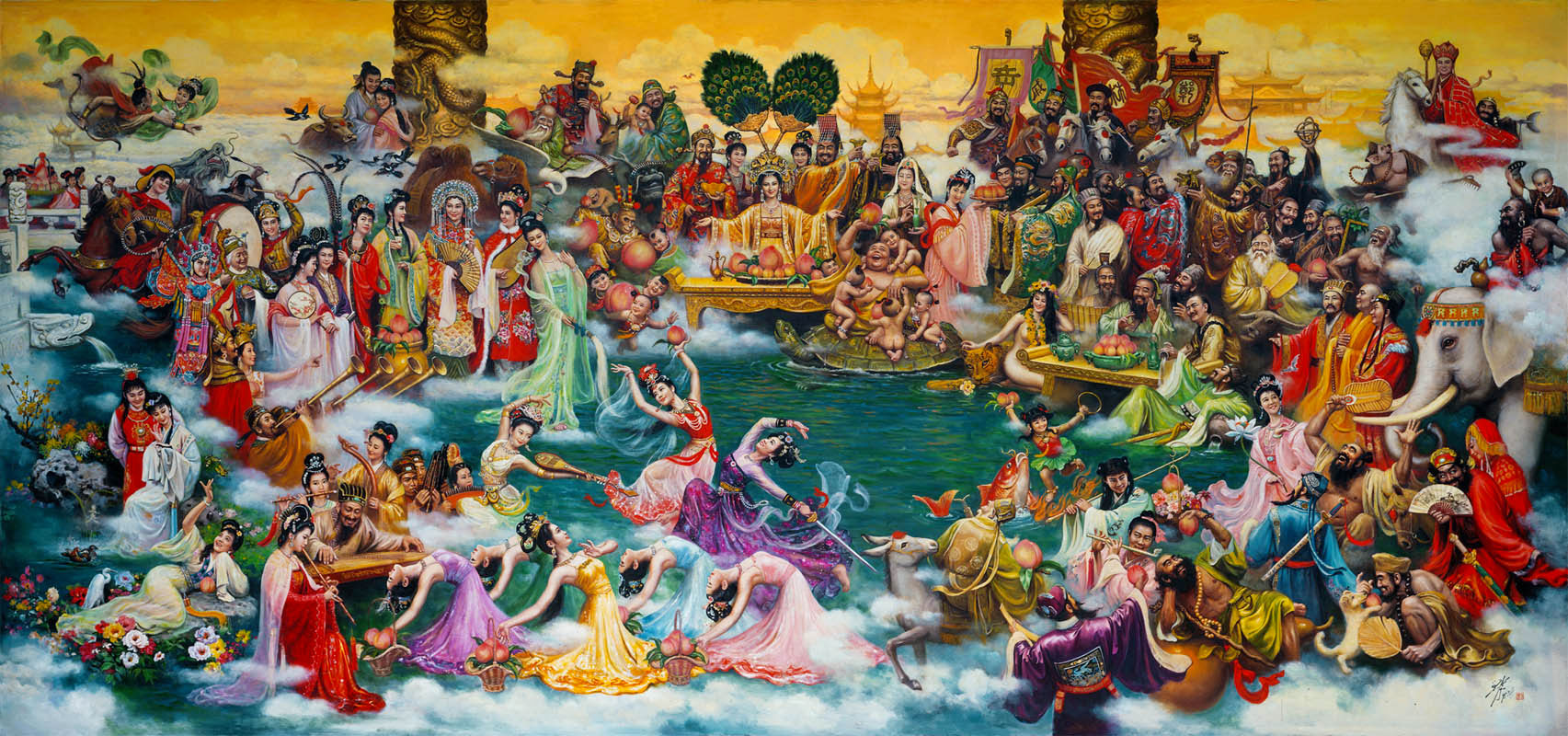
Photo credits: google.it
They are not specially worshiped, although people do accord them some veneration by placing flowers, water, and rice at their feet. Their function is to protect Buddhist law by serving the DEVA, or else, the TENBU group, that includes other divinely spiritual beings, and creatures like the Dragon, the bird-man Karura, plus Celestial Nymphs and Heavenly Musicians among them.
Most originated in the ancient Vedic traditions of India. The Sanskrit word used to refer to this celestial beings is Apsara, often represented as divine beauties and dancers who populated Lord Indra’s court in Indian mythology. In Japan the Apsaras take the name of TENNIN.
In the arts, they frequently appear as dancers and musicians adorning statues, paintings and temples in China, Japan and Southeast Asia. Their attributes are not clearly specified in Buddhist texts and therefore their appearance is quite varied. In Japan, they are often shown standing or sitting on clouds or flying in the air in graceful poses. They are often shown playing musical instruments or scattering flowers to give praise to the gods, and usually wear light and floating celestial garments, embellished with scarves of gauze, the Tenne.










